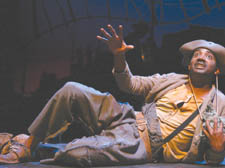|
|
 |
| |

Loukmaan Adams as Koos Sas in David Kramer’s production at the Tricyle Theatre |
Sas, the ‘bogeyman’ of the South African bush
David Kramer tells Simon Wroe how he went in search of a different side to the story of a mysterious outlaw who fought white settlers
THE story of Koos Sas, the last of the bushmen robbers, begins as it ends: with death. In 1917, Sas, an impoverished tribesman who refused to be subjugated by the white settlers, was accused of murdering a shopkeeper (the son of a clergyman) during a robbery in Montagu, South Africa.
Sas was arrested, but jail could not hold him; he escaped and went on the run. For five years he dodged the law, his notoriety growing with every whispered sighting and reported felony. When he was shot dead on sight in 1922, Sas’s reputation had reached mythological proportions: he was a bogeyman to frighten naughty children; a killer who could bend steel, outrun horses, and cheat death.
Outlaws, for all their famous deeds, seldom get the opportunity to tell their own stories. David Kramer’s re-imagining, Koos Sas: The Last Bushman of Montagu, as part of the South African Season at the Tricycle Theatre, promises to give Sas’s version of events, and in doing so it reintroduces him as a symbol of rebellion and an unlikely folk hero.
“There’s very little known about Sas – that allows one as a writer to build your own mythology around him,” explains Kramer.
“One-hundred years ago the powers that be used him because of his outlaw status to blame a lot of things on him.
“We don’t hear what the indigenous people say because it was never published.
“For me, Sas represents the very last of a resistance that took place over 200 years as his Khoisan tribe were slowly wiped out.
“They didn’t think of land in terms of something you buy or sell, it was like the air to them.
“Some of the indigenous people refused to become farmers’ servants and became stock thieves or bushmen robbers instead.
“But who is the murderer and who is the thief? Koos Sas or the people who cut up the world and sell it to one another?”
Kramer, a 57-year-old playwright and musician, has made a name across South Africa and specifically Cape Town, where he lives, as a “cultural agitator”. His first album, BAKGAT! (1980), was banned by South African broadcasters who didn’t approve of its political satire and mixing of perceived “white” and “black” languages.
In 1986 he made the transition to theatre with the help of Taliep Peterson. The songs’ stories, of civil unrest and apartheid injustice, became musicals. The two men worked together for the next 20 years, until Peterson’s murder by his wife and two professional hitmen in 2006. People came out in their thousands to pay tribute to him.
Koos Sas is Kramer’s first musical since the tragedy, though its roots go back 25 years, to when he came across the bushman’s skull in a countryside museum. With grisly irony, the thief’s body had been stolen by grave robbers and sold to the curators.
“He haunted me in some ways,” admits Kramer.
“Over the years I imagined what his story would have been. Because of our history of apartheid I’m very aware of the fact that the way history is told, only some stories survive – and the winners or the oppressors are able to tell these stories. I’ve always wanted to articulate the view of the underdog.
“So much has changed since we became a democracy, but we suffer even to this day because so many people have no sense of their own history.”
•
|

|
 |
Your comments:
|
|
 |
|

